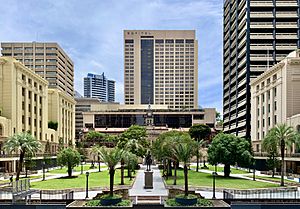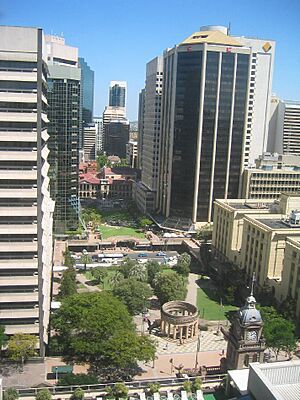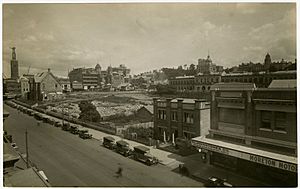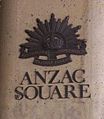ANZAC Square, Brisbane facts for kids
Quick facts for kids Anzac Square, Brisbane |
|
|---|---|

ANZAC Square—the statue in the centre of the photo is a memorial to Queenslanders who fought during the Second Boer War—1899–1902
|
|
| Location | 228 Adelaide Street, Brisbane City, City of Brisbane, Queensland, Australia |
| Design period | 1919–1930s (interwar period) |
| Built | 1928–1988 |
| Owner | Brisbane City Council |
| Official name: Anzac Square, 9th Battalion Memorial Anzac Square, Queensland Women's War Memorial | |
| Type | state heritage (built) |
| Designated | 21 October 1992 |
| Reference no. | 600062 |
| Significant period | 1928–1988 (historical) 1928–1939(park & memorials) 1988 (Korean & Vietnam War memorials) 1928– |
| Significant components | drinking fountain, pathway/walkway, memorial flame, memorial park, sculpture, shrine, wall/s, crypt / vault, steps/stairway, memorial surrounds/railings, memorial tree/avenue of trees |
| Lua error in Module:Location_map at line 420: attempt to index field 'wikibase' (a nil value). | |

ANZAC Square is a special park and war memorial in Brisbane, Queensland, Australia. It is a heritage-listed site, meaning it's protected for its historical importance. The square is named after the Australian and New Zealand Army Corps (ANZACs). It honours all the men and women from Queensland who have served in wars overseas.
ANZAC Square first opened on Armistice Day, November 11, 1930. This day marks the end of World War I. Inside the square, you'll find the Shrine of Remembrance. There is also an 'Eternal Flame of Remembrance' that has been burning since 1930.
The square also has the World War II Shrine of Memories. A famous sculptor named Daphne Mayo created the Women's War Memorial, which is part of the wall. The outside wall of the Shrine of Memories remembers the 60,000 Queenslanders who fought in World War I. You can also see statues for other wars, like the Second Boer War (1899–1902), World War II, the Vietnam War, and conflicts in Korea, Borneo, and New Guinea.
Every year on April 25, a special Dawn Service is held at the Shrine of Remembrance in ANZAC Square. This service is part of Anzac Day celebrations.
Contents
What do the symbols mean?
Anzac Square is full of symbols that help us remember important events and people.
- The 18 columns of the Shrine represent the year 1918. This was the year World War I ended and peace returned.
- The stairs leading up to the Shrine also remind us of 1918. There are 19 stairs in the first row and 18 in the second.
- The bottle trees in the square honour the Queensland Light Horse Regiments. These soldiers fought in the Boer War in South Africa.
- The palm trees are Middle East date palms. They represent Australia's success in the Middle East during both World Wars. Palms are also a traditional symbol of victory.
History of Anzac Square
World War I had a huge impact on Australia. From a small population of about five million people, 60,000 soldiers died. Another 152,000 were wounded. Australia had one of the highest casualty rates among the Allied forces.
The idea for a large memorial park in Brisbane started in 1916. People wanted a place to remember those who fought and died in the Great War. After many discussions, a smaller site was chosen in 1928. Both the state and federal governments agreed to provide land for the square.
Anzac Square was designed to remember all Queenslanders who served in wars, not just those from Brisbane. In 1928, a competition was held to design the Shrine of Remembrance. Sydney architects Buchanan and Cowper won. The Shrine and Square were officially opened on November 11, 1930, by Queensland Governor Sir John Goodwin.
In 1932, the Queensland Women's War Memorial was unveiled. This memorial was created by the Brisbane Women's Club. It was designed by Daphne Mayo with help from George Harvey.
A memorial for the 9th Battalion (AIF) was placed in the Crypt in 1937. It remembers the 45 officers and 1048 soldiers from that battalion who died in the war. This memorial was made by sculptor William Leslie Bowles.
In 1939, a memorial for Queenslanders who served in the South African conflict (1899-1902) was moved to the Square. This statue shows a mounted soldier.
Over the years, Anzac Square has become a place for memorials to other wars too. In 1984, the World War II Shrine of Memories was moved into the crypt. In 1988, memorials for the Korean War and Vietnam War were added. Anzac Square remains a very important place for remembering those who served in Australia's armed forces.
What you can see at Anzac Square
Anzac Square covers a large area between Ann and Adelaide Streets. It is a formal and organised space. From Adelaide Street, three paths lead to the large Shrine at Ann Street. These paths represent the three branches of the armed forces: Army, Navy, and Air Force. Along these paths, you'll see different trees, including Palms and Bottle Trees.
The most important part of the Square is the Shrine. It is a circular building made of sandstone and granite. It stands about 7 metres (23 feet) high. Eighteen columns support the roof. The names of battlefields where Australian soldiers fought are written inside. Inside the circular area, a bronze urn holds the Eternal Flame. This flame is a symbol of never forgetting.
Underneath the Shrine is a large crypt. This area contains the Shrine of Memories, which honours those who served in World War II. It also has other memorials dedicated to different Queensland military groups.
Two stone staircases go down from the Shrine to the rest of the Square. On either side of the stairs are shallow reflecting pools. These pools are symbols of peace and new life.
The Queensland Women's War Memorial is on the western wall of Anzac Square. It shows a carved scene of a military procession. Above it, a bronze wreath and an inscription remember the women who lost their lives because of World War I. There is also a drinking fountain with bronze dolphins, which also symbolise new life.
Near Adelaide Street, you'll see the memorial for the South African War. It's a life-size bronze statue of a Queensland Mounted Infantryman. Bronze plaques on the base list the names of the eighty-nine Queensland soldiers who died in that war.
Memorials for the Korean War and Vietnam War are also in the Square.
Anzac Square restoration
From 2014, Anzac Square underwent a big project to restore and improve it. This project was a joint effort by the Queensland Government and Brisbane City Council. The first stages involved fixing the outside of the memorial to stop water damage. They also installed a new electronic system for the Eternal Flame.
Later stages focused on improving the crypt and memorial galleries. These spaces were renamed:
- World War I Memorial Crypt (formerly the Shrine of Memories)
- World War II Gallery (formerly Memorial Crypt)
- Post World War II Memorial and Exhibition Gallery
These new galleries now have digital materials from the State Library of Queensland. They include interactive touchscreens and timelines for visitors to learn more.
Gallery
-
Second Boer War
Memorial Statue -
Shrine of Remembrance ANZAC Square façade, showing the lower section which contains the crypt with the World War II Shrine of Memories
-
World War I Memorial Sculpture on the external wall of the Shrine of Memories section of the Shrine of Remembrance
-
Shrine of Remembrance, Ann Street façade
-
ANZAC Square Shrine of Remembrance at night, taken from Ann Street, Brisbane
-
Memorial to Korea, Malaya and Borneo conflicts by Rhyl Hinwood
Heritage listing
Anzac Square is listed on the Queensland Heritage Register. This means it is recognised as an important historical site.
- It shows how Queensland's history has changed, especially regarding war memorials. It's a rare example of a large, well-designed public space.
- It is one of the few Australian war memorials that includes servicewomen.
- It has the only memorial in Brisbane dedicated to all Queenslanders who died in the South African conflict.
- It is important for its beauty and how it adds to the city centre as a large open space.
- It features the work of famous Queensland artists and sculptors like Daphne Mayo, L Watts, and W L Bowles.
- It has a strong connection to the community, especially for those involved in the armed services.
See also
 In Spanish: Plaza ANZAC para niños
In Spanish: Plaza ANZAC para niños












